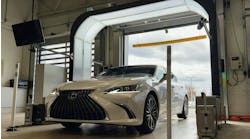So, you are ready to invest in advanced driver assist system (ADAS) equipment. By now, you realize that this isn’t like purchasing a scanner or a tire changer. It comes with a large price tag. But one kind of looks past the five-digit figure and salivates on the potential profit, and why wouldn’t you want to be a part of this $34.6 million (by 2031) industry* with a compound annual growth rate (CAGR) of more than 30 percent? There is money to be made in the bay with this new tech arm of the business.
Before you get the company checkbook out, does your P & L allow you to spend the money on this new income source? Don’t guess. Check out your sublets line -- and to whom and why. Is your shop sending business away to dealerships? Is your independent contractor bill getting out of control?
These questions need to be answered along with the recommend services column in the shop management program. Do any of the references mention ADAS? If you said, “Yes!” to any of these options, it may be time to take a deep dive into adding ADAS to your selections.
Is the shop physically capable to handle ADAS service?
Dynamic ADAS calibration/recalibration is simple: just get in the vehicle and drive according to manufacturer’s directions on the tablet plugged into the OBD2. But when targets (static) get involved, it’s another ballgame. They are special. They are vain; they want to be the only thing around the car or truck and nothing else. What does that mean to an established center? It means no banners on the wall, no structure support poles or lift posts nearby. You need to pay attention to lighting in and around the dedicated bay you choose for this reserved repair. It is a lot to ask, but your P&L depends upon the amount of space the shop has to offer to keep the books in the black.
For the smaller mom-and-pop shop operators, their footprint is going to be conservative. Therefore, they need to scrutinize their structure and weigh the pro-and-cons to offering this service onsite, knowing if they say “yes” to the service, they may be sacrificing another. But there is an alternative option: a second location.
Footprint-restricted repair facilities are adding ADAS square footage by leasing warehouse or flex space to perform calibrations/recalibrations, then supplementing other services such as HVAC or alignments in the additional space while it’s unoccupied by ADAS services. And it’s working. This may be your alternate option to gain reliable footage. The math must work before going forward with this format. Not planning for this additional square-foot costs -- and going ahead with a unit purchase -- is detrimental. The shop will lose money from day-one, creating undue financial stress on the business and a high probability of facility closure for smaller operations.
Now that we have figured out the dedicated ADAS space, it’s time to look at tool selections
There are many, many options, and there is a best way to pick out the best units for comparison that mirror the shop’s needs. Watch the manufacturers’ online promotional videos to get an idea of how this all works and what companies have to offer. Ensure the favorites reflect your customers’ ADAS needs. This is a major purchase. You do not want to spend monies on target packages that will gather dust.
Another area you need to focus on is the scanner/tablet that accompanies the ADAS hardware. Is it dedicated to the unit? Or is it a separate purchase? Can you utilize it for other, non-ADAS functions without issue? Then, there are updates to consider. Ask the factory rep about scanner/tablet software renewals. This is a cost factor into your purchase, as well. Some update pricing programs are negotiable; others are not. After the included software update time has expired, you need to find out what the pricing will be for updates. It may not seem like much, but that cost does affect the shop’s bottom line and needs to be included into your ADAS pricing.
We can’t forget about the warranty. You have the shop cost, tool reputation…and that is all important. But you do not want to make this big purchase without a manufacturer warranty? So, what could go wrong? Target-face delamination, stand integrity, inoperative laser(s), to name a few. Don’t get me wrong; nothing is made to last forever. But you want a reasonable amount of time of “wear-and-tear” before you need to purchase replacement costs.
So, who are the major players and what do they offer? (at press time):
And there are many more fledging companies out there that are manufacturing OEM targets and ADAS structures. My advice based on my ADAS purchase? Ask questions. A lot of them!
Now to decide upon which type of unit will suit the shop the best. Among single-standing manufacturer options:
- Portable stations: ADAS calibration unit that is mobile; compact, ease of travel to other shops for tuning
- Complete/fixed stations: ADAS calibration unit intended to stay in a fixed area; can be mobile, but requires large cargo area for transport
- Aligners w/ADAS: ADAS calibration unit specifically designed to remain in a fixed position; not intended for mobile applications
The third option: Aligners w/ADAS. If you are new to the world of ADAS calibration/recalibration, there is one all-important consideration you need to know: vehicle-state-of-alignment. The car or truck must be within factory (front and rear) alignment specs before your ADAS efforts work properly. I’m not saying you need to purchase an aligner; the aligner’s age has nothing to do with it. It is the ability of the technician performing the camber, caster, and toe-setting. How the vehicle sits on the roadway has everything to do with ADAS. So, at this time, upgrading your aligner is not a necessary expenditure. But it is a good time to evaluate its own calibration and useful life remaining, because all it takes is to be “off” one-degree. It doesn’t sound like much. But in the ADAS world of calibration, one degree equals one foot off in either direction within 60 feet. In 120 feet – the length of an average suburban home lot – the car or truck is in the ditch or crossing the center line into traffic. Alignments mean everything to ADAS.
If you are choosing the mobile option, a printout of the contracted shop’s recently completed alignment will be necessary for mobile techs. This documentation will confirm the angles are in proper position and proof that you calibrated/recalibrated the vehicle according to manufacturer specifications based on that completed service.
Now it’s time to take your selections for a test drive
Seriously. You wouldn’t purchase a vehicle without going around the block a time or two, would you? An in-shop presentation is the best way to get a “hands-on, feel” for the tool.
You’ve committed to a brand. Now it’s time to choose the targets. Most OEMs have a selection based on the set-level purchased. Some allow the customer to customize their targets. Others aren’t so generous, which brings up a critical topic: targets that are copies of the OEM targets. Some call them replicas; others call them knock-offs. Whatever name you have for them, they spell out trouble in the litigious world.
No matter the price, it is always in your best interest to purchase approved targets from the ADAS equipment manufacturer or OEM. No matter how many times you have chosen the cheaper alternative, eventually it will come with an accelerated price. In the courtroom. And this is how it happens:
You have recalibrated a camera on a vehicle with a knock-off/copied target. You had no problems, and you gave the customer the pre/post report. They paid the bill. A year later, the vehicle was involved in an accident. Now the vehicle history is scrutinized. The attorneys are going to ask for the shop’s repair records -- including the target purchase information. If it’s not OEM or from a licensed ADAS equipment manufacturer, suddenly the auto center is involved in crash litigation that was miles – and time -- away from the facility.
It is not worth the aggravation, litigation, or shop reputation to “go cheap"
The officially licensed targets are expensive, but that equipment expense – along with other, shop equipment – is a tax write-off in most states. Check with your advisor or accountant for specific details before counting on that tax credit.
You have purchased your best-fit ADAS unit for the shop. Now it’s time to train the shop technicians. That’s right; taking into consideration of the publicized tech shortage affecting shops – from dealership to mom-and-pop -- everyone needs to learn this process. And contrary to popular opinion, this isn’t necessarily an A-tech job, as everyone is led to believe. After a vehicle’s wheel alignment has been corrected and/or verified, the recalibration of the onboard ADAS module(s) can be performed by a B-tech or C-tech who can follow directions.
These calibration/recalibration directions are a step-by-step instructional map for anyone performing ADAS work on any car or truck, including the triangulation math. All it takes is patience to perform each task in order of appearance on the tablet connected to the vehicle.
There may be times when an A-tech needs to step-in. Usually, it’s a simple solution. Maybe a marker was moved, causing the triangulation to be improperly configured. Possibly a lighting bouncing off a target issue. There are many trivial things that can throw a wrench into the works when the operator is not paying attention to detail. But there is a more consistent, common set-up issue among ADAS techs, and the problem is sitting in the hands of the operator: the scanner/tablet.
There is a lot going on in and around the shop bay. When a repair facility really gets cranking, it’s all about what’s at hand. And, sometimes, updates are placed under the business category of: “I’ll do it later; I need the scanner now.” It may not be today or tomorrow, but this procrastination can create havoc during a calibration/recalibration; drop any tech off into the deep end of the ADAS abyss. Wasting time and energy on everyone’s part; eating-up profits.
The fix? Schedule scanner updates every morning before you open the bay doors. Not just for ADAS, but all electronically controlled devices: aligner, scanner, balancers, laptops, TPMS, and the list goes on…just make sure your list is up to date every day. No one – owner to tech – likes dealing with a false positive adjustment.
You need to let everyone know that you are ADAS calibration/recalibration-capable
This announcement should not be restricted to your present clientele. Obviously, advertise to the general public in your market that your shop is now the dealership alternative for performing ADAS. Then, take it one step further: B2B. Let area shops know that you are willing to provide this service. Make dealerships aware that your facility is available to take on their ADAS overflow. Then, let insurance companies know that your business is another ADAS calibration/recalibration option. Tell everyone that your shop is the new, ADAS “go-to” facility.
This piece pointed out many of the pros and cons of ADAS service and the money to be made calibrating/recalibrating modules. And there are many factors to consider before spending $25,000 to $30,000 on a piece of equipment. Don’t be blinded by the green glow of profit. Your customers are counting on the bay doors to remain open for business. Choose this service wisely.
*Research & Markets, 2021




